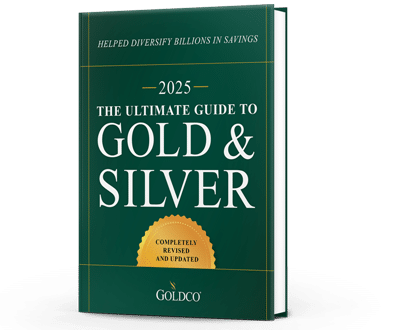Everything You Need to Know About a Gold IRA Transfer
With everything going on in the economy today, more and more people are concerned about their financial security Recession fears are high, and memories of 2008 are still at the back of many...
Precious Metals

It’s probably no surprise to most people that the United States is suffering under the burden of heavy debt. Governments, corporations, and households are all more indebted than they ever have been before. And the coming debt bomb could crush the economy once these debts start to default.
We’ve seen defaults in the US before, most notably during the 2008 financial crisis. That crisis saw what many of us had long feared, a cascading series of defaults as homeowners walked away from mortgages while banks and lenders started to default after the income they expected was no longer coming in. An entire house of cards built on securitizing mortgages, grouping them together, and calling subprime mortgages AAA-rated nearly caused the entire US financial system to collapse.
If you thought debt levels were high back then, they’re even higher today. The total federal government debt in the third quarter of 2008 was $10 trillion. Today it’s nearly triple that, over $28 trillion. Total corporate debt peaked at $6.5 trillion in 2008, and has increased to over $11 trillion today. And total household debt has gone from $14.3 trillion in 2008 to nearly $17 trillion today.
It would be one thing if the US economy were on a tear and economic growth were sufficient to support that debt growth. But the economy isn’t in great shape, with millions of Americans still out of work, and economic growth still hasn’t rebounded back to pre-pandemic growth levels. If things continue at this rate, or get worse, many indebted companies and individuals will have a hard time paying their debts.
Are Bonds Getting Riskier?
Bonds have traditionally been seen as a more conservative investment asset, favored by those nearing retirement. Conventional wisdom is that younger investors should invest mostly in stocks with a small percentage of investments in bonds, and gradually increase the percentage of investments in bonds as they approach retirement. But in a world that’s so heavily indebted, with more and more debt being added to the already enormous debt pile each year, are bonds really a safe investment anymore?
A growing amount of newly-issued debt, particularly corporate debt, is of low quality, barely investment grade. And the amounts of that debt continue to increase. Even junk bonds, also known as high-yield bonds, don’t offer nearly the returns they used to. And that has investors faced with a dilemma: stick with tried and true sovereign or high-rated corporate bonds and make yields that are lower than inflation, or take riskier bets to get the same yields you used to get two decades ago.
As the economy worsens, however, more and more companies are defaulting. And we’ve learned a very harrowing lesson from last year’s COVID lockdowns, namely that investors won’t be able to recoup nearly what they would have expected.
In the event of a bond default that results from bankruptcy, a company’s creditors get in line to split up the assets of the company. Certain types of bonds are senior to others, so those later in line are often left fighting for scraps.
Historically, bondholders have been able to recoup on average over 50 cents on the dollar for their holdings on defaulted bonds. During the 2008 financial crisis, the average recovery was 59 cents on the dollar. But for companies that shut down as a result of the COVID lockdowns, investors only recouped 45 cents on the dollar.
Even worse is that these averages understate the haircut that certain bondholders will take. Those holding loans, who are most senior in bankruptcy, made out the best. Meanwhile, some classes of bondholders recovered only one penny on the dollar.
Imagine holding what you thought were safe, sound bonds that would help provide you income in retirement, only to discover that some of them lose 99% of their value during the next crisis. That’s a scenario that all too many investors may find themselves in in the future.
With the vast amounts of new debt being issued, many of the companies issuing them are quickly becoming zombie companies. Those are companies whose incomes are just enough to service the deb they’ve issued, but not enough to repay that debt.
Once a company enters zombie territory, it can be very hard to dig itself out of that hole. Becoming a zombie company is generally an indicator that a company is no longer viable, and it’s only a matter of time before the company goes under.
Nearly 20% of all large corporations in the US today are considered zombie companies, holding well over $2 trillion of debt. And 16% of large companies worldwide are considered zombie companies. That doesn’t bode well for the future of those companies, the future of the economy, or the future of those companies’ investors.
Alternatives to Bonds?
Risk is an inherent part of every investment you make. And while bonds may have at one time been considered less risky investments, it can be argued that that may no longer be true. Certainly if you’re holding bonds of one of the United States’ hundreds of zombie companies, you may be wondering if your principal will ever be repaid.
When the massive corporate debt bubble finally collapses, it will be like a massive debt bomb exploding throughout the economy. Bondholders large and small will feel its effects, and it won’t be pretty.
Many investors today are trying to find alternatives to bonds, assets that will provide income in retirement while still maintaining their value. They look at bond defaults and the struggle to recoup value and begin to get nervous. And increasingly they’re beginning to look at gold and silver as alternative investments.
Gold and silver may not pay interest like bonds do, but they never lose their principal. An ounce of gold is an ounce of gold, today, tomorrow, and 100 years into the future. And gold historically has maintained its purchasing power over time, unlike paper money.
During times of crisis, gold and silver can even make greater gains, such as during the 1970s stagflation when gold and silver averaged greater than 30% annualized gains, or in the aftermath of the 2008 financial crisis when gold nearly tripled and silver more than quintupled. That type of performance catches the attention of those looking to maximize their gains while still protecting their wealth.
If you’re nearing retirement and heavily invested in a conventional mix of stocks and bonds, what steps have you taken to protect your retirement savings? With stocks set for a correction and bond markets looking increasingly uneasy, isn’t it worth it to develop and implement a strategy to protect the investments you’ve worked so hard to acquire?
Don’t let decades of hard work, saving, and investment go to waste because of a massive debt bomb. Talk to the experts at Goldco today to find out how gold and silver can help protect your precious retirement savings.

